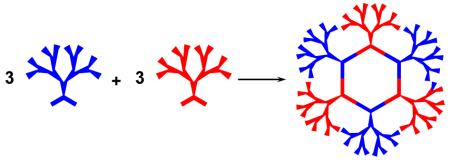Abstract
A new class of 120° dendritic di-Pt(II) acceptor subunits has been designed and synthesized, from which six-component hexagonal metallodendrimers were easily formed with 120° dendritic dipyridine donors via [3+3] coordination-driven self-assembly. The structures of all metallodendrimers are confirmed by multinuclear NMR, ESI-TOF-MS/ESI-FTMS, and elemental analysis. MMFF force-field simulations indicates that all metallodendrimers have a hexagonal ring with an internal radius of approximately 1.4 nm.
Since the pioneering work by Newkome et al.1 and Balzani et al.2 in the early 1990s, metallodendrimers3 have evolved to be one of the most attractive fields within supramolecular chemistry. Compared to the synthesis of conventional dendrimers that rely heavily on carbon-carbon or carbon-heteroatom bond formation, metal-donor interactions have been shown to function as the key growth steps in the construction of metallodendrimers. The highly efficient formation of coordination bonds offers considerable synthetic advantages such as fewer steps, fast and facile construction of the final products, and inherently self-correcting, detect-free assembly. More importantly, the incorporation of metals endows desirable properties to the resulting metallodendrimers. This new family of dendrimers has been extensively explored as potential functional materials in catalysis4, biological mimetics5, and in photo- and electrochemistry6. Recently, dendritic metallocycles have received considerable attention because of their potential application in the recognition and delivery of guests incorporated within their cavities.7 However, the precise control of the size and the shape of the metallodendrimers remains a challenge.
Coordination-driven self-assembly8 has been demonstrated to be a powerful and facile approach to the construction of polygons and polyhedra9 with well-designed shapes, sizes, and symmetry. By employing such a strategy, we have previously constructed a series of functionalized metallacycles10 including well-defined metallodendrimers11 with various size and shape. For example, by combining predesigned 120° angular dendritic organic donors with 180° di-Pt(II) acceptors, “snowflake-shaped” [6+6] metallodendrimers11b were prepared via coordination-driven self-assembly. More recently, a new family of metallodendritic squares has been synthesized from 4,4′-bipyridines funtionalized with Fréchet-type dendrons and (dppp)Pt(II) or Pd(II) triflate by Schalley et al.12
According to the “symmetry interaction” model8a,8e, 120° anglular building units are required for hexagonal assemblies whereas 108° anglar units lead to the production of pentagonal structures. As supramolecular structures increase in size they also tend toward increasing flexibility. For large, complex supramolecular hexagons, small distortions away from the ideal bond angles of the subunits can occur and make up for the necessary 12° difference per corner between a hexagon and a pentagon. Although no evidence for any other species, such as pentagonal assemblies, was found in multinuclear NMR or mass spectroscopy studies during the formation of [6+6] hexagonal metallodendrimers11b, it is necessary to find alternative means to prepare six-component hexagonal metallodendrimers that rule out the possibility of forming pentagonal structures entirely.
In general, the shape of an individual two-dimensional polygon is determined by the value of the turning angle within its angular components. According to the “directional bonding” and “symmetry interaction” models8a,e, discrete hexagonal entities can be self-assembled via the combination of two complementary ditopic building blocks A2 and X2, each incorporating 120° angels between their coordination sites, allowing for the formation of hexagonal structures of type A23X23.13 This strategy, in contrast to the use of six 120° angular units and six 180° linear units that results in larger and more flexible hexagonal assemblies, is able to rule out the possibility of the formation of alternative, non-hexagonal species. Herein, we report the synthesis, via [3+3] coordination-driven self-assembly, of six-component hexagonal metallodendrimers from the newly designed 120° di-Pt(II) acceptor 1 and 120° dipyridine donor 2 (Figure 1), both of which are substituted with Fréchet-type dendrons.
FIGURE 1.
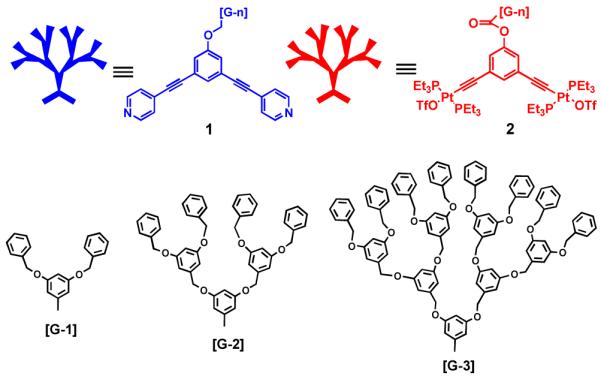
Schematic and molecular structure of 120° dendritic donor subunit 1 and 120° dendritic acceptor subunit 2.
The 120° dendritic di-Pt(II) acceptors 2a-c can be easily synthesized as shown in Scheme 1. The Fréchet-type dendrons ([G-1]-[G-3]) were introduced by a coupling reaction of 3 with the different generation dendritic carboxylic acids14. Compounds 4a-c were then reacted with 4 equiv of trans-PtI2(PEt3)2 to give diiodo metal complexes 5a-c. Subsequent halogen abstraction with AgOTf resulted in the isolation of bistriflate salts 2a-c in reasonable yield. The 31P{1H} NMR spectra of diplatinum acceptors 2a-c displayed singlets at 22.19, 22.65, and 22.56 ppm, respectively, each accompanied by flanking 195Pt satellites.
SCHEME 1. Synthesis of 120° Dendritic Di-Pt(II) Acceptor Subunits 2a-c.
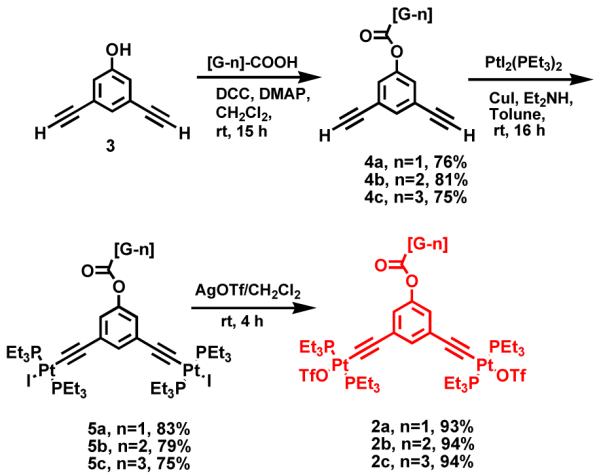
Single crystals of [G-1] di-Pt(II) diiodide complex 5a, suitable for X-ray diffraction studies, were grown by slow evaporation of a dichloromethane/methanol solution (1/1) at ambient temperature for 2-3 days. An ORTEP representation of the structure of 5a (Figure 2) shows that it is indeed a suitable candidate for a 120° building unit, with the angle between the two platinum coordination planes being approximately 124°. The distance between the two Pt centers in 5a is ∼1.0 nm.
FIGURE 2.
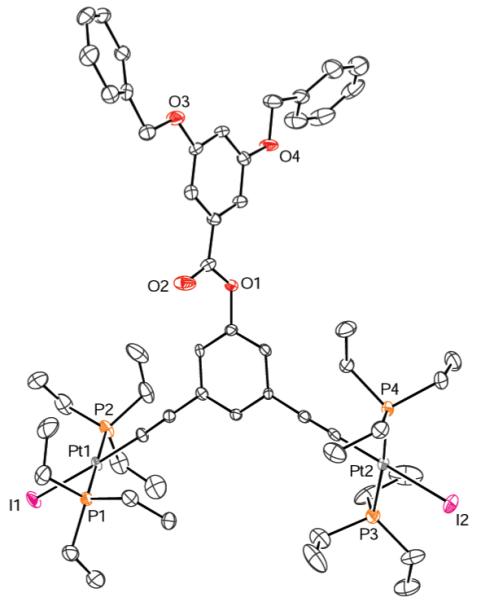
ORTEP diagram of 120° [G-1] di-Pt(II) diiodide complex 5a. Thermal ellipsoids are drawn to 30% probability.
When [G-1]-[G-3] 120° dendritic donor subunits 1a-c were reacted with 120° dendritic di-Pt(II) acceptors 2a-c in CD2Cl2 at room temperature, the [3+3] six-component hexagonal metallodendrimers 6a-c, respectively, were formed (Scheme 2). 31P{1H} NMR analysis of the reaction mixtures is consistent with the formation of single, highly symmetric species as indicated by the appearance of a sharp singlet (ca. 16.2 ppm) with concomitant 195Pt satellites, shifted upfield by ca. 6.4 ppm as compared to 2a-b. This change, as well as the decrease in coupling of the flanking 195Pt satellites (ca. Δ1JPPt = -62 Hz for 6a; Δ1JPPt = -64 Hz for 6b; Δ1JPPt = -67 Hz for 6c), is consistent with back-donation from the platinum atom, lending further support to the formation of the supramolecular complexes. In the 1H NMR spectra of metallodendrimers 6a-c, the β-H of the pyridine rings exhibited ca. 0.40-0.51 ppm downfield shifts relative to uncoordinated 5a-d due to the loss of electron density that occurs upon coordination of the pyridine-N atom with the Pt (II) metal center. Upon stirring at 298 K for 72 h, the 31P{1H} and 1H NMR of assemblies 6a-c do not show any significant change, demonstrating the stability of these novel supramolecular assemblies. The sharp NMR signals in both the 31P{1H} and 1H NMR spectra (see supporting information) along with the solubility of these species ruled out the formation of oligomers.
SCHEME 2.
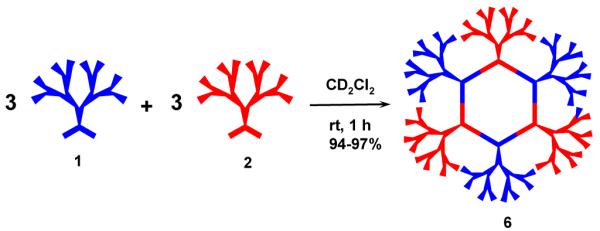
Self-Assembly of Six-Component Hexagonal Metallodendrimers via [3+3] Coordination-Driven Self-Assembly
Mass-spectrometric studies of metallodendrimers 6a-d were performed by ESI-TOF-MS and ESI-FTMS spectrometry, which allows the assemblies to remain intact during the ionization process in order to obtain the high resolution required for unambiguous determination of individual charge-states. The high molecular weight and complex isotope splitting of such charged multi-platinum species necessitates high-resolution mass spectral analysis in order to determine their absolute molecular weight and their molecularity, which reveals the absolute stoichiometry of constituent subunits and can definitively rule out the possibility of supramolecular pentagon assembly.
All results of mass studies of assemblies 6a-c have provided strong support for the formation of hexagonal metallodendrimers. In the ESI-TOF-MS spectra of [G-1] and [G-2] assemblies 6a and 6b, peaks at m/z =1513.0 and m/z =1180.6 for 6a and m/z =2149.7 and m/z =1690.0 for 6b, corresponding to the charge states [M - 4 OTf]4+ and [M - 5 OTf]5+, respectively, were observed and their isotopic resolutions are in excellent agreement with the theoretical distributions (Figure 3A-D). Given the significantly larger molecular weight (14278.7 Da) of the [G-3] hexagonal metallodendrimer it is more difficult to get strong mass signals even under the ESI-TOF-MS conditions. With considerable effort, a peak at m/z = 2708.8 was observed in the ESI-FTMS spectrum of [G-3]-assembly 6c, which corresponds to the [M - 5 OTf]5+ charge state. The peak was isotopically resolved (Figure 3E) and agrees well with the theoretical distribution, although overlap with the signal of a minor unknown fragment, which could not be attributed to any alternative polygonal supramolecules, was also observed.
Figure 3.
Calculated (top) and experimental (bottom) ESI-TOF-MS spectra of metallodendrimers 6a (A and B) and 6b (C and D), and ESI-FTMS spectra of metallodendrimer 6c (E).
We have demonstrated that [3+3] hexagonal structures can be self-assembled by combining three 120° pyridyl donor building blocks and three 120° di-platinum acceptors13. Furthermore, recent studies have indicated that the addition of functional groups at the vertices of individual building units, such as ferrocene and crown ether moieties, does not hinder the formation of [3+3] self-assembled metallosupramolecules.13a,d,f Close examination of the ESI mass spectra of 6a-c revealed no peaks indicating the formation or existence of [2+2] rhomboidal or [4+4] octagonal structures. It should again be noted that it is not possible to form polygons with an odd number of sides (i.e. pentagon, heptagon, etc.) by combining 120° donors with 120° acceptors as they would require the direct connection of either two acceptor or two donor moieties. The lack of mass spectral peaks corresponding to other polygon architectures and the singularity of each 31P NMR signal ensures that only [3+3] hexagonal metallodendrimers are formed in each self-assembly.
Large supramolecular coordination-compounds and flexible, high generation dendrimers often prove difficult to crystalize. Likewise, all attempts to grow X-ray quality single crystals of hexagonal metallodendrimers 6a-c have proven to be unsuccessful to date. MMFF force-field simulations were employed to optimize the geometry of all metallodendrimers 6a-c (For [G-1] and [G-2], see supporting information). Simple space filling models of the simulated structures indicate that each of 6a-c have a very similar, roughly planar hexagonal ring at their core surrounded by flexible dendrons. In the case of 6c, the hexagonal ring-shaped metallodendrimer has an internal radius of approximately 1.4 nm while the outer dendron radius averages 3.5 nm (Figure 4).
FIGURE 4.
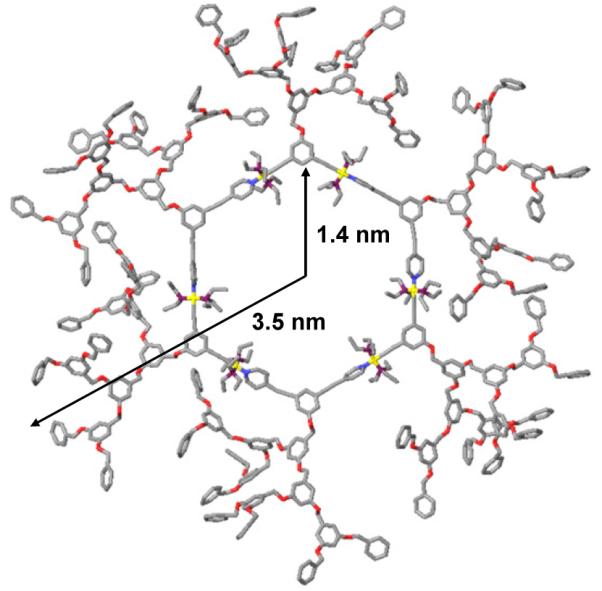
Simulated molecular model of [G-3] six-component hexagonal metallodendrimer 6c (C = grey, O = red, N = blue, P = purple, Pt = yellow; hydrogen atoms have been removed for clarity).
In summary, we have designed and synthesized a new class of 120° dendritic di-Pt(II) acceptor subunits, from which six-component hexagonal metallodendrimers can be easily formed via [3+3] coordination-driven self-assembly, thus enriching the library of dendritic metallocycles. More importantly, compared to previous reports of the synthesis of six-component hexagonal metallodendrimers, this study provides another highly efficient approach to the construction of such species that unambiguously avoid the possible formation of other polygons caused by small distortions of the subunit bond angles. All metallodendrimers are characterized with multinuclear NMR, ESI-TOF-MS/ESI-FTMS, and elemental analysis. Their structural properties have been studied using MMFF force-field simulations, which indicate that all metallodendrimers have hexagonal rings with internal radii of approximately 1.4 nm. This research has once again proven the versatility and modularity of the directional bonding approach to self-assembly, which surely will be employed to the synthesis of other functional dendritic metallocycles in the future.
Experimental Section
General Procedure for the Preparation of Six-Component Hexagonal Metallodendrimers 6a-c
To a 0.5 mL dichloromethane-d2 solution of triflate 2a-c (for 2a, 5.40 mg, 0.00334 mmol; for 2b, 5.95 mg, 0.00291 mmol; for 2c, 5.70 mg, 0.00197 mmol) was added a 0.5 mL dichloromethane-d2 solution of the appropriate [G-1]-[G-3] dendric donor precursors 1a-c (for 1a, 2.0 mg, 0.00334mmol; for 1b, 2.98 mg, 0.00291 mmol; for 1c, 3.69 mg, 0.00197 mmol) drop by drop with continuous stirring (10 min). The reaction mixture was stirred for 1 h at room temperature. The solution was evaporated to dryness, and the product was collected.
6a Yield
7.10 mg (pale yellow solid), 96%. 1H NMR (CD2Cl2, 300 MHz): B 8.63 (d, J = 6.3 Hz, 12H), 7.81 (d, J = 6.3 Hz, 12H), 7.59 (s, 3H), 7.31-7.44 (m, 72H), 7.08 (s, 3H), 6.95 (s, 6H), 6.91 (s, 3H), 6.70 (s, 6H), 6.60 (s, 3H), 5.13 (s, 12H), 5.11 (s, 6H), 5.06 (s, 12H), 1.80-1.83 (m, 72H), 1.13-1.24 (m, 108H). 31P{1H} NMR (CD2Cl2, 121.4 MHz): B 16.12 (s, 1JPt-P = 2299.8 Hz). Anal. Calcd for C294H330F18N6O39P12 Pt6S6: C, 53.11; H, 5.00; N, 1.26. Found: C, 53.45; H, 5.23; N, 1.52.
6b Yield
8.42 mg (pale yellow solid), 97%. 1H NMR (CD2Cl2, 300 MHz): δ 8.61 (d, J = 6.3 Hz, 12H), 7.80 (d, J = 6.3 Hz, 12H), 7.60 (s, 3H), 7.35-7.43 (m, 132H), 7.07 (s, 3H), 6.95 (s, 6H), 6.88 (s, 3H), 6.69 (s, 30H), 6.58 (s, 15H), 5.01-5.10 (m, 78H), 1.79-1.81 (m, 72H), 1.12-1.23 (m, 108H). 31P{1H} NMR (CD2Cl2, 121.4 MHz): δ 16.18 (s, 1JPt-P = 2310.1 Hz). Anal. Calcd for C462H474F18N6O63P12Pt6S6: C, 60.35; H, 5.20; N, 0.91. Found: C, 60.18; H, 5.46; N, 0.98.
6c Yield
8.83 mg (pale yellow glassy solid), 94%. 1H NMR (CD2Cl2, 300 MHz): δ 8.58 (s, 12H), 7.78 (d, J = 6.3 Hz, 12H), 7.61 (s, 3H), 7.32-7.40 (m, 252H), 7.06 (s, 3H), 6.94 (s, 6H), 6.87 (s, 3H), 6.69 (br, 78H), 6.58 (br, 39H), 4.97-5.00 (m, 174H), 1.79-1.81 (m, 72H), 1.12-1.23 (m, 108H). 31P{1H} NMR (CD2Cl2, 121.4 MHz): δ 16.15 (s, 1JPt-P = 2305.8 Hz). Anal. Calcd for C798H762F18N6O111P12Pt6S6: C, 67.08; H, 5.38; N, 0.59. Found: C, 66.78; H, 5.51; N, 0.61.
Supplementary Material
Acknowledgment
P.J.S. thanks the NIH (Grant GM-057052) for financial support. B.H.N. thanks the NIH (Grant GM-080820) for financial support. D.C.M. and M.M.L. thank NCBC and NCSU for generous financial support.
REFERENCES
- 1.Newkome GR, Moorefield F, Vögtle F, Baker GR, Johnson AL, Behara RK. Angew. Chem., Int. Ed. Engl. 1991;30:1176–1178. [Google Scholar]
- 2.Denti G, Serroni S, Campagana S, Ricevuto V, Balzani V. Inorg. Chim. Acta. 1991;182:127–129. [Google Scholar]
- 3.(a) Newkome GR, Moorefield F, Vögtle F. Dendritic Molecules: Concepts, Synthesis, Properties. VCH; Weinheim, Germany: 1996. [Google Scholar]; (b) Constable EC. Chem. Commun. 1997:1073–1080. [Google Scholar]; (c) Zeng F, Zimmerman SC. Chem. Rev. 1997;97:1681–1712. doi: 10.1021/cr9603892. [DOI] [PubMed] [Google Scholar]; (d) Newkome GR, He E, Moorefield CN. Chem. Rev. 1999;99:1689–1746. doi: 10.1021/cr9800659. [DOI] [PubMed] [Google Scholar]; (e) Bosman AW, Janssen HM, Meijer EW. Chem. Rev. 1999;99:1665–1688. doi: 10.1021/cr970069y. [DOI] [PubMed] [Google Scholar]; (f) Balzani V, Campagna S, Denti G, Juris A, Serroni S, Venturi M. Acc. Chem. Res. 1998;31:26–34. [Google Scholar]; (g) Gorman CB, Smith JC. Acc. Chem. Res. 2001;34:60–71. doi: 10.1021/ar000044c. [DOI] [PubMed] [Google Scholar]; (h) Astruc D. Acc. Chem. Res. 2000;33:287–298. doi: 10.1021/ar9901319. [DOI] [PubMed] [Google Scholar]; (i) Crooks RM, Zhao M, Sun L, Chechik V, Yeung LK. Acc. Chem. Res. 2001;34:181–190. doi: 10.1021/ar000110a. [DOI] [PubMed] [Google Scholar]; (j) Selby HD, Roland BK, Zheng Z. Acc. Chem. Res. 2003;36:933–944. doi: 10.1021/ar020134c. [DOI] [PubMed] [Google Scholar]; (k) Huck WTS, van Veggel FCJM, Reinhoudt DN. Angew. Chem., Int. Ed. Engl. 1996;35:1213–1215. [Google Scholar]; (l) Enomoto M, Aida T. J. Am. Chem. Soc. 1999;121:874–875. [Google Scholar]; (m) Hwang S-H, Shreiner CD, Moorefield CN, Newkome GR. New J. Chem. 2007:1192–1217. [Google Scholar]; (n) Constable EC. Chem. Soc. Rev. 2007;36:246–253. doi: 10.1039/b601166g. [DOI] [PubMed] [Google Scholar]
- 4.(a) Astruc D, Chardac F. Chem. Rev. 2001;101:2991–3023. doi: 10.1021/cr010323t. [DOI] [PubMed] [Google Scholar]; (b) Becker JJ, Gagné MR. Acc. Chem. Res. 2004;37:798–804. doi: 10.1021/ar000102u. [DOI] [PubMed] [Google Scholar]; (c) Astruc D, Ornelas C, Ruiz J. Acc. Chem. Res. 2008;41:841–856. doi: 10.1021/ar8000074. [DOI] [PubMed] [Google Scholar]; (d) Bonomi R, Selvestrel F, Lombardo V, Sissi C, Polizzi S, Mancin F, Tonellato U, Scrimin P. J. Am. Chem. Soc. 2008;130:15744–15745. doi: 10.1021/ja801794t. [DOI] [PubMed] [Google Scholar]
- 5.(a) Enomoto M, Aida T. J. Am. Chem. Soc. 1999;121:874–875. [Google Scholar]; (b) Percec V, Dulcey AE, Peterca M, Ilies M, Sienkowska MJ, Heiney PA. J. Am. Chem. Soc. 2005;127:17902–17909. doi: 10.1021/ja056313h. [DOI] [PubMed] [Google Scholar]
- 6.(a) Adronov A, Fréchet JMJ. Chem. Commun. 2000:1701–1710. [Google Scholar]; (b) Jiang H, Lee SJ, Lin W. Org. Lett. 2002;4:2149–2152. doi: 10.1021/ol0259037. [DOI] [PubMed] [Google Scholar]; (c) Choi M-S, Yamazaki T, Yamazaki I, Aida T. Angew. Chem., Int. Ed. 2004;43:150–158. doi: 10.1002/anie.200301665. [DOI] [PubMed] [Google Scholar]; (d) Mo Y-J, Jiang D-L, Uyemura M, Aida T, Kitagawa T. J. Am. Chem. Soc. 2005;127:10020–10027. doi: 10.1021/ja042196z. [DOI] [PubMed] [Google Scholar]; (e) Maury O, Bozec HL. Acc. Chem. Res. 2005;38:691–704. doi: 10.1021/ar020264l. [DOI] [PubMed] [Google Scholar]; (f) Hwang S-H, Moorefield CN, Newkome GR. Chem. Commun. 2008;37:2543–2557. doi: 10.1039/b803932c. [DOI] [PubMed] [Google Scholar]
- 7.(a) Gorman CB, Smith JC. J. Am. Chem. Soc. 2000;122:9342–9343. [Google Scholar]; (b) Wang P, Moorefield CN, Newkome GR. Org. Lett. 2004;6:1197–1200. doi: 10.1021/ol0364529. [DOI] [PubMed] [Google Scholar]
- 8.(a) Stang PJ, Olenyuk B. Acc. Chem. Res. 1997;30:502–518. [Google Scholar]; (b) Leininger S, Olenyuk B, Stang PJ. Chem. Rev. 2000;100:853–908. doi: 10.1021/cr9601324. [DOI] [PubMed] [Google Scholar]; (c) Seidel SR, Stang PJ. Acc. Chem. Res. 2002;35:972–983. doi: 10.1021/ar010142d. [DOI] [PubMed] [Google Scholar]; (d) Schwab PFH, Levin MD, Michl J. Chem. Rev. 1999;99:1863–1934. doi: 10.1021/cr970070x. [DOI] [PubMed] [Google Scholar]; (e) Caulder DL, Raymond KN. Acc. Chem. Res. 1999;32:975–982. [Google Scholar]; (f) Gianneschi NC, Masar MS, III, Mirkin CA. Acc. Chem. Res. 2005;38:825–837. doi: 10.1021/ar980101q. [DOI] [PubMed] [Google Scholar]; (g) Cotton FA, Lin C, Murillo CA. Acc. Chem. Res. 2001;34:759–771. doi: 10.1021/ar010062+. [DOI] [PubMed] [Google Scholar]; (h) Fujita M, Tominaga M, Hori A, Therrien B. Acc. Chem. Res. 2005;38:369–378. doi: 10.1021/ar040153h. [DOI] [PubMed] [Google Scholar]; (i) Fiedler D, Leung DH, Bergman RG, Raymond KN. Acc. Chem. Res. 2005;38:349–358. doi: 10.1021/ar040152p. [DOI] [PubMed] [Google Scholar]; (j) Steel PJ. Acc. Chem. Res. 2005;38:243–250. doi: 10.1021/ar040166v. [DOI] [PubMed] [Google Scholar]
- 9.(a) Fujita M, Oguro D, Miyazawa M, Oka H, Yamaguchi K, Ogura K. Nature. 1995;378:469–471. [Google Scholar]; (b) Olenyuk B, Levin MD, Whiteford JA, Shield JE, Stang PJ. J. Am. Chem. Soc. 1999;121:10434–10435. [Google Scholar]; (c) Olenyuk B, Whiteford JA, Fechtenkotter A, Stang PJ. Nature. 1999;398:796–799. doi: 10.1038/19740. [DOI] [PubMed] [Google Scholar]; (d) Takeda N, Umemoto K, Yamaguchi K, Fujita M. Nature. 1999;398:794–794. [Google Scholar]; (e) Fujita M, Fujita N, Ogura K, Yamaguchi K. Nature. 1999;400:52–55. [Google Scholar]; (f) Davis AV, Raymond KN. J. Am. Chem. Soc. 2005;127:7912–7919. doi: 10.1021/ja051037s. [DOI] [PubMed] [Google Scholar]; (g) Hiraoka S, Sakata Y, Shionoya M. J. Am. Chem. Soc. 2008;130:10058–10059. doi: 10.1021/ja803115j. [DOI] [PubMed] [Google Scholar]; (h) Hiraoka S, Harano K, Shiro M, Ozawa Y, Yasuda N, Toriumi K, Shionoya M. Angew. Chem. Int. Ed. 2006;45:6488–6491. doi: 10.1002/anie.200601431. [DOI] [PubMed] [Google Scholar]
- 10.(a) Northrop BH, Yang H-B, Stang PJ. Chem. Commun. 2008:5896–5908. doi: 10.1039/b811712h. [DOI] [PMC free article] [PubMed] [Google Scholar]; (b) Yang H-B, Ghosh K, Northrop BH, Zheng Y-R, Lyndon MM, Muddiman DC, Stang PJ. J. Am. Chem. Soc. 2007;129:14187–14189. doi: 10.1021/ja073744m. [DOI] [PMC free article] [PubMed] [Google Scholar]; (c) Yang H-B, Ghosh K, Zhao Y, Northrop BH, Lyndon MM, Muddiman DC, White HS, Stang PJ. J. Am. Chem. Soc. 2008;130:839–841. doi: 10.1021/ja710349j. [DOI] [PMC free article] [PubMed] [Google Scholar]; (d) Ghosh K, Yang H-B, Northrop BH, Lyndon MM, Zheng Y-R, Muddiman DC, Stang PJ. J. Am. Chem. Soc. 2008;130:5320–5334. doi: 10.1021/ja711502t. [DOI] [PubMed] [Google Scholar]; (e) Northrop BH, Glöckner A, Stang PJ. J. Org. Chem. 2008;73:1787–1794. doi: 10.1021/jo702380b. [DOI] [PubMed] [Google Scholar]; (f) Ghosh K, Zhao Y, Yang H-B, Northrop BH, White HS, Stang PJ. J. Org. Chem. 2008;73:8553–8557. doi: 10.1021/jo801692v. [DOI] [PMC free article] [PubMed] [Google Scholar]
- 11.(a) Yang H-B, Das N, Huang F, Hawkridge AM, Muddiman DC, Stang PJ. J. Am. Chem. Soc. 2006;128:10014–10015. doi: 10.1021/ja063377z. [DOI] [PubMed] [Google Scholar]; (b) Yang H-B, Hawkridge AM, Huang SD, Das N, Bunge SD, Muddiman DC, Stang PJ. J. Am. Chem. Soc. 2007;129:2120–2129. doi: 10.1021/ja066804h. [DOI] [PubMed] [Google Scholar]
- 12.Baytekin HT, Sahre M, Rang A, Engeser M, Schulz A, Schalley CA. Small. 2008;4:1823–1834. doi: 10.1002/smll.200800135. [DOI] [PubMed] [Google Scholar]
- 13.Leininger S, Schmitz M, Stang PJ. Org. Lett. 1999;1:1921–1923. doi: 10.1021/ol9911425. [DOI] [PubMed] [Google Scholar]
- 14.Xie D, Jiang M, Zhang G, Chen D. Chem. Eur. J. 2007;13:3346–3353. doi: 10.1002/chem.200601361. [DOI] [PubMed] [Google Scholar]
Associated Data
This section collects any data citations, data availability statements, or supplementary materials included in this article.



